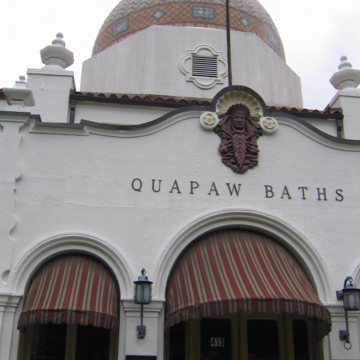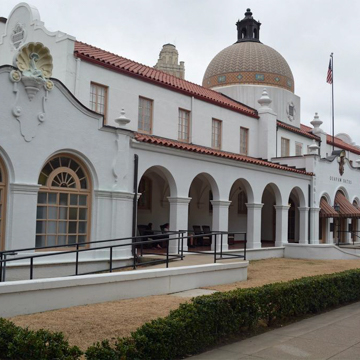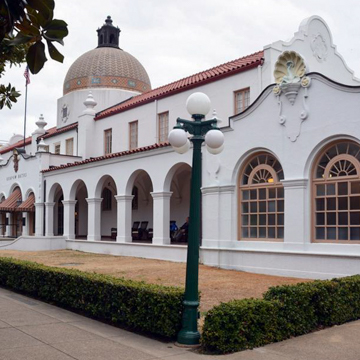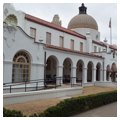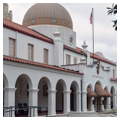The Quapaw bathhouse takes its name from one of the Indian tribes in Arkansas; coincidentally, Native American artifacts were uncovered during the excavations for the building’s basement. The Spanish Colonial Revival bathhouse is entirely covered in white stucco and is fronted by a central arched portico and a full-width arcade. Set over the entrance is a cartouche bearing the carved image of an Indian set in a decorative double-curved parapet. Double-curved parapets also balance the north and south ends of the building, both of which are capped with scalloped shells framing small spiny fish, an aquatic theme that appears elsewhere in the building. The most striking feature and the one that sets this building apart on Bathhouse Row is the large central dome set upon an octagonal base, encased in colorful tiles, and capped with a copper cupola. Two large finials projecting from the roofline of the second story frame the distinctive dome and enhance the entrance. The Quapaw was intended to be more moderately priced than the Fordyce (GA6) or the Maurice (GA7) bathhouses, and the separate facilities for men and women—bathing, showers, vapor treatment and cooling rooms—were all on the ground floor. The compact second story housed dressing rooms and a writing room. The Quapaw ceased operations in 1984, but it was renovated and updated by Taylor Kempkes Architects as a modern-day spa and reopened in 2007 for mixed bathing in the several pools.
You are here
Quapaw Baths and Spa (Quapaw Bathhouse)
If SAH Archipedia has been useful to you, please consider supporting it.
SAH Archipedia tells the story of the United States through its buildings, landscapes, and cities. This freely available resource empowers the public with authoritative knowledge that deepens their understanding and appreciation of the built environment. But the Society of Architectural Historians, which created SAH Archipedia with University of Virginia Press, needs your support to maintain the high-caliber research, writing, photography, cartography, editing, design, and programming that make SAH Archipedia a trusted online resource available to all who value the history of place, heritage tourism, and learning.


